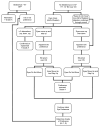Fixation preference and visual acuity testing in a population-based cohort of preschool children with amblyopia risk factors
- PMID: 18962921
- PMCID: PMC2699252
- DOI: 10.1016/j.ophtha.2008.08.031
Fixation preference and visual acuity testing in a population-based cohort of preschool children with amblyopia risk factors
Erratum in
- Ophthalmology. 2009 Feb;116(2):174
Abstract
Purpose: To compare the clinical assessment of fixation preference (FP) to visual acuity (VA) in a population-based sample of preschool children with amblyopia risk factors.
Design: Evaluation of diagnostic test in a population-based study.
Participants: 243 children with anisometropia and/or strabismus, aged 30 to 72 months, living in Los Angeles County, CA [corrected]
Methods: Before measuring VA, FP testing was performed at near and usually without correction, using the binocular fixation pattern in children with strabismus >10 prism diopters (Delta), or the induced tropia test for children with strabismus <or=10Delta or without strabismus. We determined the sensitivity and specificity of FP testing for predicting unilateral amblyopia, defined by optotype VA, among children with amblyopia risk factors.
Main outcome measure: Grade of FP.
Results: Sensitivity of FP testing for amblyopia among children with anisometropia was 20% (9/44) and specificity was 94% (102/109). Among strabismic children, sensitivity was 69% (9/13; worse in children 30-47 than 48-72 months old) and specificity was 79% (70/89), with similar findings for esotropia and exotropia.
Conclusion: The ability of FP testing to correctly identify amblyopia in preschool children with amblyopia risk factors is poor. Clinicians should be wary of using FP as a surrogate measure of interocular difference in VA in young children.
Financial disclosure(s): The authors have no proprietary or commercial interest in any materials discussed in this article.
Figures
References
-
- Laws D, Noonan CP, Ward A, Chandna A. Binocular fixation pattern and visual acuity in children with strabismic amblyopia. J Pediatr Ophthalmol Strabismus. 2000;37:24–8. - PubMed
-
- Knapp P, Moore S. Diagnostic procedures in an orthoptic evaluation. Am Orthopt J. 1962;12:63–9. - PubMed
-
- Zipf RF. Binocular fixation pattern. Arch Ophthalmol. 1976;94:401–5. - PubMed
-
- Wright KW, Walonker F, Edelman P. 10-Diopter fixation test for amblyopia. Arch Ophthalmol. 1981;99:1242–6. - PubMed
Publication types
MeSH terms
Grants and funding
LinkOut - more resources
Full Text Sources
Medical


